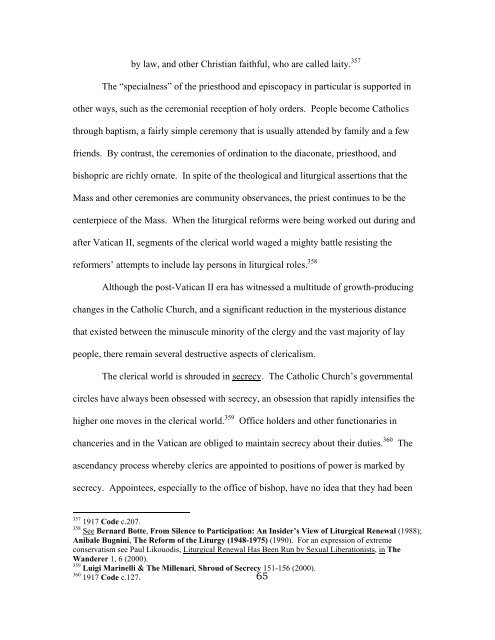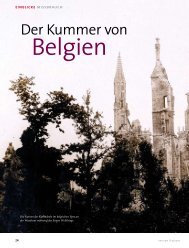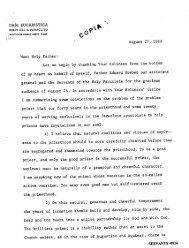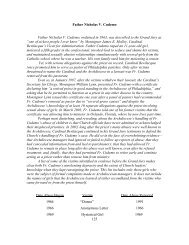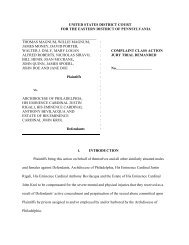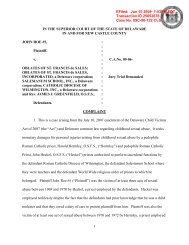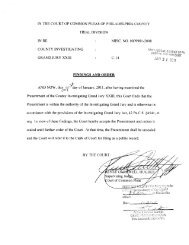1 1 Catholic Clergy Sexual Abuse Meets the Civil Law by Thomas P ...
1 1 Catholic Clergy Sexual Abuse Meets the Civil Law by Thomas P ...
1 1 Catholic Clergy Sexual Abuse Meets the Civil Law by Thomas P ...
Create successful ePaper yourself
Turn your PDF publications into a flip-book with our unique Google optimized e-Paper software.
y law, and o<strong>the</strong>r Christian faithful, who are called laity. 357<br />
The “specialness” of <strong>the</strong> priesthood and episcopacy in particular is supported in<br />
o<strong>the</strong>r ways, such as <strong>the</strong> ceremonial reception of holy orders. People become <strong>Catholic</strong>s<br />
through baptism, a fairly simple ceremony that is usually attended <strong>by</strong> family and a few<br />
friends. By contrast, <strong>the</strong> ceremonies of ordination to <strong>the</strong> diaconate, priesthood, and<br />
bishopric are richly ornate. In spite of <strong>the</strong> <strong>the</strong>ological and liturgical assertions that <strong>the</strong><br />
Mass and o<strong>the</strong>r ceremonies are community observances, <strong>the</strong> priest continues to be <strong>the</strong><br />
centerpiece of <strong>the</strong> Mass. When <strong>the</strong> liturgical reforms were being worked out during and<br />
after Vatican II, segments of <strong>the</strong> clerical world waged a mighty battle resisting <strong>the</strong><br />
reformers’ attempts to include lay persons in liturgical roles. 358<br />
Although <strong>the</strong> post-Vatican II era has witnessed a multitude of growth-producing<br />
changes in <strong>the</strong> <strong>Catholic</strong> Church, and a significant reduction in <strong>the</strong> mysterious distance<br />
that existed between <strong>the</strong> minuscule minority of <strong>the</strong> clergy and <strong>the</strong> vast majority of lay<br />
people, <strong>the</strong>re remain several destructive aspects of clericalism.<br />
The clerical world is shrouded in secrecy. The <strong>Catholic</strong> Church’s governmental<br />
circles have always been obsessed with secrecy, an obsession that rapidly intensifies <strong>the</strong><br />
higher one moves in <strong>the</strong> clerical world. 359 Office holders and o<strong>the</strong>r functionaries in<br />
chanceries and in <strong>the</strong> Vatican are obliged to maintain secrecy about <strong>the</strong>ir duties. 360 The<br />
ascendancy process where<strong>by</strong> clerics are appointed to positions of power is marked <strong>by</strong><br />
secrecy. Appointees, especially to <strong>the</strong> office of bishop, have no idea that <strong>the</strong>y had been<br />
357<br />
1917 Code c.207.<br />
358<br />
See Bernard Botte, From Silence to Participation: An Insider’s View of Liturgical Renewal (1988);<br />
Anibale Bugnini, The Reform of <strong>the</strong> Liturgy (1948-1975) (1990). For an expression of extreme<br />
conservatism see Paul Likouodis, Liturgical Renewal Has Been Run <strong>by</strong> <strong>Sexual</strong> Liberationists, in The<br />
Wanderer 1, 6 (2000).<br />
359<br />
Luigi Marinelli & The Millenari, Shroud of Secrecy 151-156 (2000).<br />
360<br />
1917 Code c.127.<br />
65


